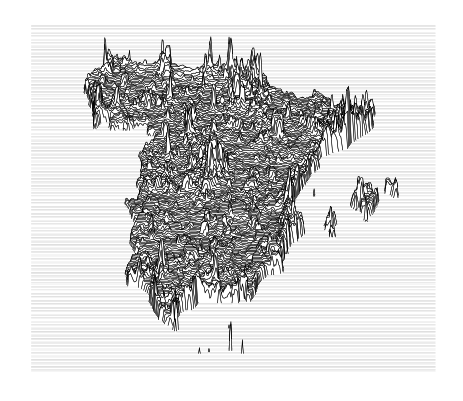Me too, me too!

Las alturas corresponden a una cierta potencia de la población residente en la correspondiente rejilla. Los datos son del SEDAC (Socioeconomic Data and Applications Center, Universidad de Columbia) y se pueden bajar gratis si te registras y rellenas un cuestionario tontaina.
El código,
library(ggplot2)
options(expressions = 10000)
dat <- read.table("dat/espp00ag.asc", skip = 6)
dat <- as.matrix(dat)
dat <- data.frame(y = as.numeric(row(dat)),
x = as.numeric(col(dat)),
pop = as.numeric(dat))
peninsula <- dat[dat$x > 200,]
peninsula <- peninsula[peninsula$y < 250,]
res <- ggplot()
for (i in 1:max(peninsula$y)){
tmp <- peninsula[peninsula$y == i,]
tmp$pop <- tmp$pop^0.3
res <- res + geom_polygon(data = tmp, aes(x = x, y = pop - y), fill = "white", col = "black", size = 0.1)
res <- res + geom_path(data = tmp, aes(x = x, y = pop - y), size = 0.2)
res <- res + geom_hline(data = tmp, aes(yintercept = -y), col = "white")
}
res + theme(axis.line=element_blank(),
axis.text.x=element_blank(),
axis.text.y=element_blank(),
axis.ticks=element_blank(),
axis.title.x=element_blank(),
axis.title.y=element_blank(),
legend.position="none",
panel.background=element_blank(),
panel.border=element_blank(),
panel.grid.major=element_blank(),
panel.grid.minor=element_blank(),
plot.background=element_blank())Nota: se me olvidó escribir en el cuerpo lo que anunciaba el título, i.e., que esta entrada está inspirada (fusilada, de hecho) en lo esencial de otras previas.

